Verona
We did a sightseeing driving with the overview of the city, that allows you to see Castelvecchio and Gavi’s Arch, the church of San Zeno. The visit continues with a walk in Old Town, characteristic and the most important historical and artistic, as Juliet's House, Signori’s Square, Herb’s Quare, Scaliger’s Arch, Church of St. Anastasia. We saw the Arena also inside, that is the fourth-largest Roman amphitheater in the world.
Castel Vecchio
Castel Vecchio is erected in the mid-fourteenth century by Cangrande II della Scala, after the Arena is the most grandiose and imposing monument of the city. Originally it was called Castle of San Martino in Aquaro, but later it took the name of the Old Castle. It 'a very large castle, which is important for its imposing appearance and its shape decidedly military and the seven corner towers, covered. The complex consists in two parts, divided by the imposing thirteenth century walls. At the left is the Scaligeri palace, protected by a narrow courtyard with a double row of walls. At the center stands the high main tower (Torre del Mastio), which is near the river bridge Scaligero, with three arches, and fortified battlements, that integrates the defensive system of the castle. On the right side of the structure is a large rectangular courtyard, originally intended to parade; the center is located a curious fountain in the shape of dog, symbol of fidelity Scala. During the first decades of the twentieth century, it underwent a first major renovation to become a museum. In January 1944 hosted the process of Verona with whom were sentenced to death and Galeazzo Ciano, Fascist leaders who had lay Benito Mussolini and at the end of the war was damaged by the bombings of the Allies. From 1958 to 1964, the fortress of Castelvecchio was the subject of a new restoration. The result is a "masterpiece of the Italian museum design, with very valid solutions and imitated in more than thirty years later." Today the castle houses the Museo Civico of Verona which is one of the largest collections of Italian art and sculpture gallery.
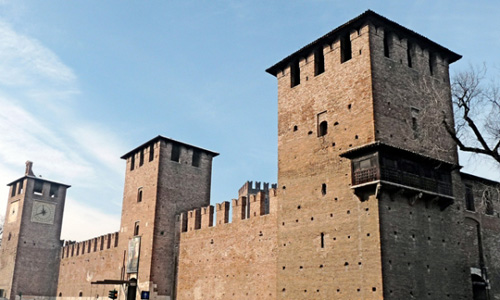
Top
Arco dei Gavi
Built by the Romans in the early first century, the Gavi Arch is a rare example of a celebratory bow dedicated to a family of private citizens. An elegant four-sided arch elongated rectangular plan, built using heavy blocks of white stone. It has a structure with two main and two secondary. On the main fronts are four Corinthian columns; the two middle frame the opening while the angular delimit the sides of the monument. Although its form memories that triumphal arches, it is actually a celebratory bow that was built to honor several members of the family Gavia. Lost over the centuries its celebratory function, in medieval times the Arch of Gavi became one of the main gateways to Verona. Originally, the Gavi Arch had a position that was different from today. In fact it was placed in front of the clock tower of Castelvecchio. It was dismantled in August 1805 by the occupation troops of Napoleon, who believed he could to obstruct the transit of military tanks in their entry into the city. It was reconstructed in 1932 in the present location. The filmmaker, whose name is on the left pillar of the prospect facing the river Adige, is Lucio Vitruvius Cerdone.
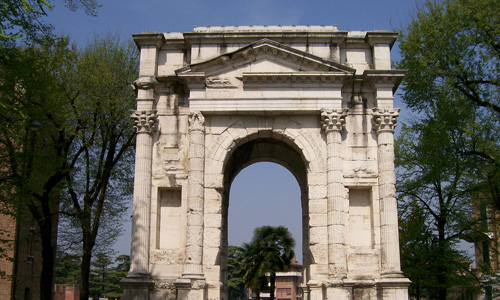
Top
Chiesa di San zeno
Main Romanesque masterpiece in Italian, the Basilica of San Zeno is one of the most important buildings of the city. And it’s dedicated to the eighth Bishop of Verona, a saint of African origin to which are attributed many miracles. Through numerous works it came to take on the current forms late first millennium: a church with three naves and three apses, as wide as the current, but shorter and equipped with crypt. Elongated and enlarged after the devastating earthquake which hit Verona in 1117 and throughout northern Italy, was completed in 1398. The facade features a large rose window, it was one of the first Romanesque windows. Under the canopy are the porch, simple and elegant architectural structure supported by columns resting on lions, with sculptural decorations that represent figures of months, prophets and plants. The portal is a valuable artifact lined with 48 bronze panels, where there are scenes from the life of Christ and the Old Testament. On the portal sides deserve attention even the bas-reliefs of the XII century. To the right of the church stands a bell tower of 72 meters. The interior, with a Latin cross plan with three naves, presents a peculiar split on three levels: The crypt, at the bottom, topped by the first priest from the parish church and then accessed by two majestic marble staircases. The most valuable works are housed in the main apse: the beautiful triptych of Mantegna depicting the Madonna Enthroned, and the great marble statue of San Zeno, depicts the saint smiling while holding the pastoral staff from which hangs a fish. The central staircase leads to the crypt, which preserves the body of the saint.
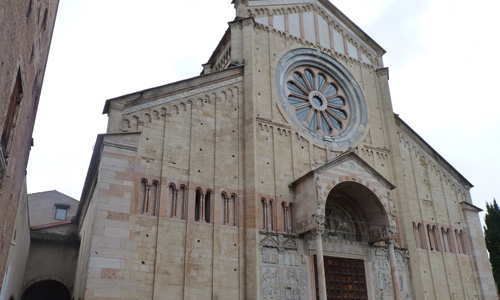
Top
Casa di Giulietta
At 23 Via Cappello, a few dozen meters from Piazza delle Erbe, stands the house where, according to tradition, lived Juliet Capulet. Arrived at the inner courtyard is the beautiful bronze statue of Juliet and a plaque on which are some verses of Shakespeare's tragedy. The house is a medieval building, whose brick facade is softened by elegant trefoil windows. On the front is the famous balcony on which Juliet traditionally overlooked to speak with her Romeo.
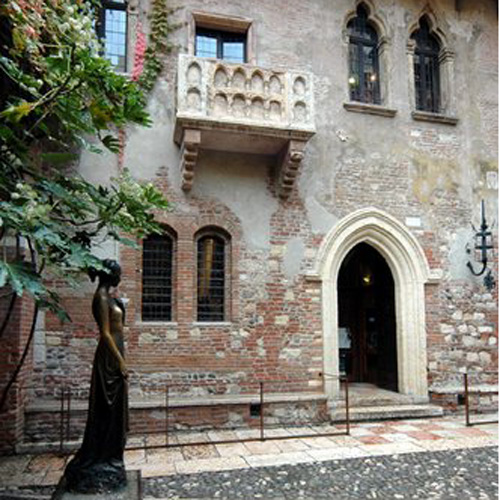
Top
Piazza delle Erbe
Herb’s Quare is an enchanted corner of Verona. A corner where palaces, towers, statues and architectural elements from various periods they overlapped, creating a layered collage harmonious, unique and unrepeatable. In international guides is often presented as one of the most beautiful squares in Italy.
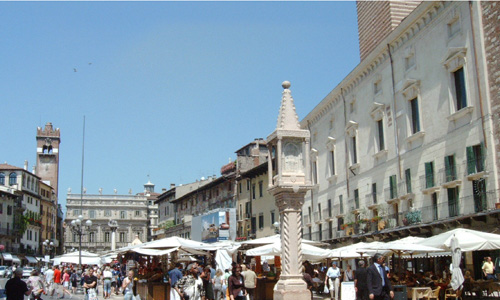
Top
Piazza dei Signori
The difference between Herb’s Quare and Signori’s Square, though located next to each other, appears immediate and considerable: the Herb’s Quare is articulated, popular and typical "Italian" as Signori’s Square is harmonious, aristocratic collection. In medieval times, it hosted the court of the Lordship of the Scaligeri.
Top
Arche Scaligere
A monumental tomb, majestic and spectacular, which for over seven hundred years houses the mortal remains of the ancient Lords of Verona. Here lie the principles of the Della Scala family, with their elaborate equestrian sculptures that rise into the sky like an endless tournament petrified.
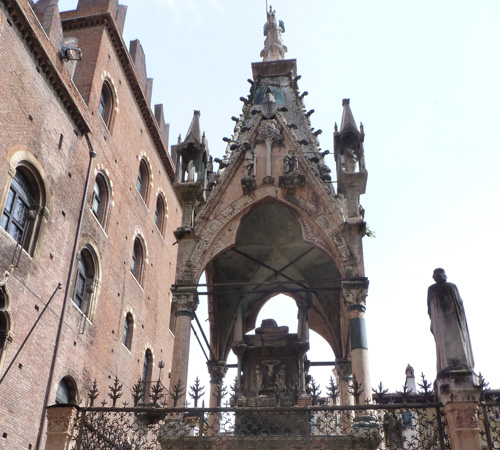
Top
Chiesa Santa Anastasia
Set in a small square, the medieval Basilica of St. Anastasia is the largest church in Verona. It 'also the most important Gothic monument in the city, where there are works of art of priceless value. Work on the construction of the basilica of Saint Anastasia began at the end of the thirteenth century and continued until the consecration which took place in 1471. The brick façade is made up of a porch decorated with paintings and sculptures. They see frescoes of the fifteenth century depicting the Holy Trinity; the lintel floor is decorated with simple carvings of Christ's life. The interior of the basilica is solemn and majestic, in the shape of a Latin cross and divided into three naves joined with vaults; the aisles separated by twelve columns in white and red marble from Verona with Gothic capitals with floral motifs. The aisles the church have an uninterrupted sequence of great altars, decorated with elegant blades, frescoes and sculptures from Fourteenth to the eighteenth century. Among the many wonders mention the altar Fregoso, the altar of St. Thomas Aquinas, the Cappella Cavalli, Pellegrini chapel and finally, in the presbytery, the monument Seregno. The church contains the famous and spectacular fresco San Giorgio and Princess. By Antonio Pisano and ultimate expression of international Gothic in Verona, it is visible in the Cappella Pellegrini.
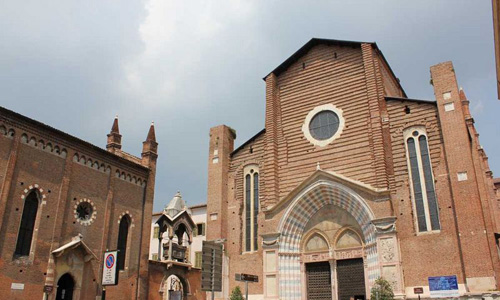
Top
Arena
The magnificent amphitheater is the monument that more than any other recalls the Roman origins of the city and also the symbol of Verona all over the world. Every summer, more than a century, its imposing stone steps welcome six hundred thousand spectators the largest open-air opera season in the world. The Arena of Verona is a magnificent amphitheater, the third largest among those left to us and the best preserved, although in 1183 a strong earthquake has destroyed the triple order of overlapping arches that surrounded him entirely. Today remains of the hanging only a glimpse, a wing formed by four bays that can imagine the grandeur of the original appearance; perfectly intact presents instead the internal order. It was built in the first century after Christ with the marble extracted from quarries in the province. The oval interior has a major axis of about seventy-four meters and a minor axis of forty-five meters. The large auditorium is formed for forty-five steps that have an average height of as many centimeters. During the years of the empire he received numerous gladiatorial combat, and over the centuries hosted performances of all kinds: tournaments, jousts, duels, ballets, circuses and representations of prose. For over a century, it houses a magnificent opera season; the first opera to be performed August 10, 1913 was Aida, the most spectacular of the Verdi operas. They rushed to Verona thousands of spectators from all over Italy and the world. She was born the largest open-air opera season in the world and since then the number of spectators has always honored its Inventors: every summer the amphitheater hosts 600,000 spectators spread over fifty evenings, with five or six productions that alternate, which was attended by all the greatest singers of the world.
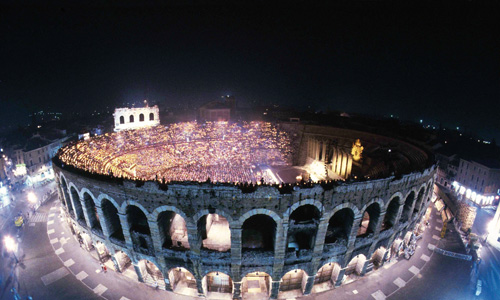
Top